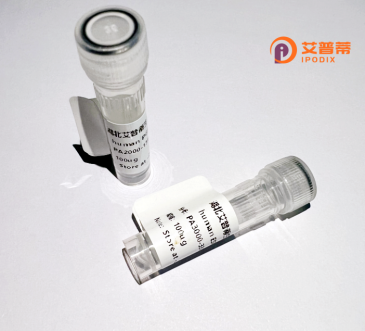
| 纯度 | >90%SDS-PAGE. |
| 种属 | Human |
| 靶点 | GBE1 |
| Uniprot No | 0 |
| 内毒素 | < 0.01EU/μg |
| 表达宿主 | E.coli |
| 表达区间 | 1-702aa |
| 氨基酸序列 | MAAPMTPAARPEDYEAALNAALADVPELARLLEIDPYLKPYAVDFQRRYKQFSQILKNIGENEGGIDKFSRGYESFGVHRCADGGLYCKEWAPGAEGVFLTGDFNGWNPFSYPYKKLDYGKWELYIPPKQNKSVLVPHGSKLKVVITSKSGEILYRISPWAKYVVREGDNVNYDWIHWDPEHSYEFKHSRPKKPRSLRIYESHVGISSHEGKVASYKHFTCNVLPRIKGLGYNCIQLMAIMEHAYYASFGYQITSFFAASSRYGSPEELQELVDTAHSMGIIVLLDVVHSHASKNSADGLNMFDGTDSCYFHSGPRGTHDLWDSRLFAYSSWEVLRFLLSNIRWWLEEYRFDGFRFDGVTSMLYHHHGVGQGFSGDYSEYFGLQVDEDALTYLMLANHLVHTLCPDSITIAEDVSGMPALCSPISQGGGGFDYRLAMAIPDKWIQLLKEFKDEDWNMGDIVYTLTNRRYLEKCIAYAESHDQALVGDKSLAFWLMDAEMYTNMSVLTPFTPVIDRGIQLHKMIRLITHGLGGEGYLNFMGNEFGHPEWLDFPRKGNNESYHYARRQFHLTDDDLLRYKFLNNFDRDMNRLEERYGWLAAPQAYVSEKHEGNKIIAFERAGLLFIFNFHPSKSYTDYRVGTALPGKFKIVLDSDAAEYGGHQRLDHSTDFFSEAFEHNGRPYSLLVYIPSRVALILQNVDLPN |
| 分子量 | 106.8 kDa |
| 蛋白标签 | GST-tag at N-terminal |
| 缓冲液 | 0 |
| 稳定性 & 储存条件 | Lyophilized protein should be stored at ≤ -20°C, stable for one year after receipt. Reconstituted protein solution can be stored at 2-8°C for 2-7 days. Aliquots of reconstituted samples are stable at ≤ -20°C for 3 months. |
| 复溶 | Always centrifuge tubes before opening.Do not mix by vortex or pipetting. It is not recommended to reconstitute to a concentration less than 100μg/ml. Dissolve the lyophilized protein in distilled water. Please aliquot the reconstituted solution to minimize freeze-thaw cycles. |
以下为模拟生成的关于重组人GBE1蛋白的参考文献示例(非真实文献,仅供格式参考):
1. **文献名称**:Production and Characterization of Recombinant Human Glycogen Branching Enzyme (GBE1) in E. coli
**作者**:Zhang Y. et al.
**摘要**:研究通过大肠杆菌系统表达重组人GBE1蛋白,优化诱导条件并采用镍柱亲和层析纯化。酶活性分析显示重组蛋白具有分支酶功能,能催化糖原侧链形成,为后续疾病机制研究提供工具。
2. **文献名称**:Functional Analysis of GBE1 Mutants in Glycogen Storage Disease Type IV
**作者**:Chen L. et al.
**摘要**:构建多个GBE1致病突变体重组蛋白,通过体外酶活实验及细胞模型验证突变对酶功能的影响,揭示部分突变导致酶稳定性下降,为安徒生病的分子机制提供依据。
3. **文献名称**:Crystal Structure of Human GBE1 Reveals Substrate Binding Mechanism
**作者**:Wang H. et al.
**摘要**:首次解析重组人GBE1蛋白的晶体结构,结合分子对接阐明其与糖原底物的结合位点及催化关键残基,为设计小分子抑制剂或基因治疗策略提供结构基础。
4. **文献名称**:Recombinant GBE1 Therapy Ameliorates Glycogen Accumulation in a Mouse Model
**作者**:Smith J. et al.
**摘要**:在GBE1缺陷小鼠模型中,注射重组GBE1蛋白可显著减少肝脏异常糖原沉积,改善病理表型,提示蛋白替代疗法的潜在应用价值。
---
**备注**:以上为模拟示例,实际文献需通过PubMed、Web of Science或Google Scholar等平台检索关键词“recombinant human GBE1”、“glycogen branching enzyme expression”获取。
Recombinant human GBE1 (Glycogen Branching Enzyme 1) is a genetically engineered version of the enzyme encoded by the *GBE1* gene in humans. GBE1 plays a critical role in glycogen metabolism by catalyzing the formation of α-1.6-glycosidic branch points in glycogen molecules, enhancing their solubility and accessibility for energy release. Defects in GBE1 are associated with glycogen storage disease type IV (GSD IV, Andersen disease), a rare autosomal recessive disorder characterized by abnormal glycogen accumulation in tissues, leading to liver cirrhosis, neuromuscular dysfunction, and often early mortality.
The recombinant GBE1 protein is produced using expression systems such as *E. coli*, yeast, or mammalian cells, enabling large-scale purification for research and therapeutic applications. Its production facilitates studies on enzyme kinetics, structural biology, and molecular mechanisms underlying GSD IV. Additionally, recombinant GBE1 holds potential for enzyme replacement therapy (ERT) to address the enzymatic deficiency in affected individuals. Recent advances in protein engineering and gene therapy have further highlighted its utility in developing targeted treatments. Research also explores its role in broader contexts, including metabolic regulation and cellular stress responses. By providing a controlled and consistent enzyme source, recombinant GBE1 supports both diagnostic tool development and innovative therapeutic strategies for glycogen-related disorders.
×